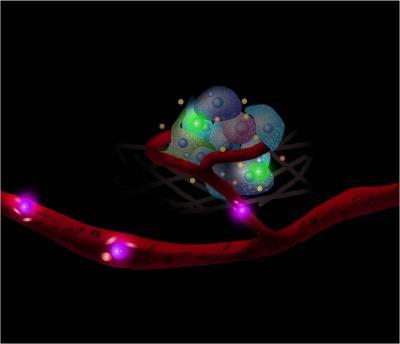据美国科学日报的报道,布里格姆妇女医院(BWH)研究人员开发出实时监测单细胞间相互作用的细胞膜传感器。这一发明有助于进一步理解复杂的细胞生物学、监测移植细胞的生长情况以及为疾病研发出有效的治疗方法,因而满足科学和医学共同的需要。相关研究发表在7月17日Nature Nanotechnology 期刊上。

实时监测单个细胞间相互作用
BWH医院再生治疗中心高级研究员Jeffrey Karp称,我们能在前所未有的时间和空间高清晰度下实时监视单个细胞与其它细胞如何“对话”,从而能够了解细胞间与药物对细胞作用的详细信息。在基础科学和新药研发领域,此信息的应用前景非常广阔。
研究人员目前使用的细胞通讯传感器,其功能局限在检测一组细胞的活动。
利用纳米技术将传感器锚定在单一细胞组上,研究人员可以在纳米水平上监测细胞间的可溶性信号。
考虑到传感器被直接标记在细胞上,移植细胞或组织可应用这一技术,进而能监测它们在受体中的迁移和生理活动。
指导作者 Weian Zhao 称,一旦新技术被进一步精炼成一种工具,规范化地研究药物和细胞之间的相互作用,有望用于未来的个性化医疗领域。BWH医院再生治疗中心 Jeffrey Karp补充说,或许有一天,为每一位病人开出对症药方之前,我们能够检测药物对细胞间相互作用的影响。
通过新技术实时追踪、监测移植细胞,获取的初步数据令研究人员异常兴奋。此外,该技术将用于深入地研究炎症部位和干细胞微环境的信号事件,而这些信号事件对许多疾病的治疗具有重要意义。
没有参与研究的哈佛大学医学院 Ulrich von Andrian 免疫病理学教授称,以实时、空间高清晰的方式窃听原生环境中细胞之间通讯,此研究是朝着这一目标迈出的重要一步,并在新药研发和病症诊断方面具有深远意义。
这项工作由国家卫生部和美国细胞协会资助。(生物探索译 Pobee)
生物探索推荐英文原文
Monitoring Cellular Interactions at Nano-Scale in More Detail Than Ever Before
Using nanotechnology to engineer sensors onto the surface of cells, researchers at Brigham and Women's Hospital (BWH) have developed a platform technology for monitoring single-cell interactions in real-time. This innovation addresses needs in both science and medicine by providing the ability to further understand complex cell biology, track transplanted cells, and develop effective therapeutics. These findings are published in the July 17 issue of Nature Nanotechnology.
"We can now monitor how individual cells talk to one another in real-time with unprecedented spatial and temporal resolution," says Jeffrey Karp, senior study author, and co-director of the Center for Regenerative Therapeutics (ReGen Rx) at BWH. "This allows us to understand signaling between cells and interactions with drugs in great detail that should have broad implications for basic science and drug discovery",.
The cell-signaling sensors researchers currently use are limited to measuring the activity in the bulk environment that a group of cells are in. In this study, researchers used nanotechnology to anchor a sensor to the membrane of individual cells, allowing them to monitor soluble signals within the cellular nanoenvironment. Given that cells are directly labeled with sensors permits application to transplanted cells or tissues.
"Once this is refined as a tool, and used to study drug interactions with cells on a regular basis, there is potential that it may be used for personalized medicine in the future," said Weian Zhao, lead author of the study, also of the Center for Regenerative Therapeutics (ReGen Rx) at BWH. Karp adds, "We may one day be able to test a drug's influence on cell-cell interactions before deciding on the appropriate therapeutic for each person."
The researchers are also especially excited by preliminary data that demonstrates the potential to use this engineering approach to track and monitor the environment surrounding transplanted cells, in real time, which was never before possible. This would be useful for developing a deeper understanding of signaling events that define a site of inflammation for example or the stem cell niche, which may have implications for treatment of many diseases.
"This new study takes a significant step toward the goal to eavesdrop in real-time and at high spatial resolution on communications between cells in their native environment, with far-reaching implications for the development of new drugs and diagnostics" said Ulrich von Andrian, the Mallinckrodt Professor of Immunopathology at Harvard Medical School who was not involved in this study.
This work was funded by the National Institutes of Health and the American Heart Association.







